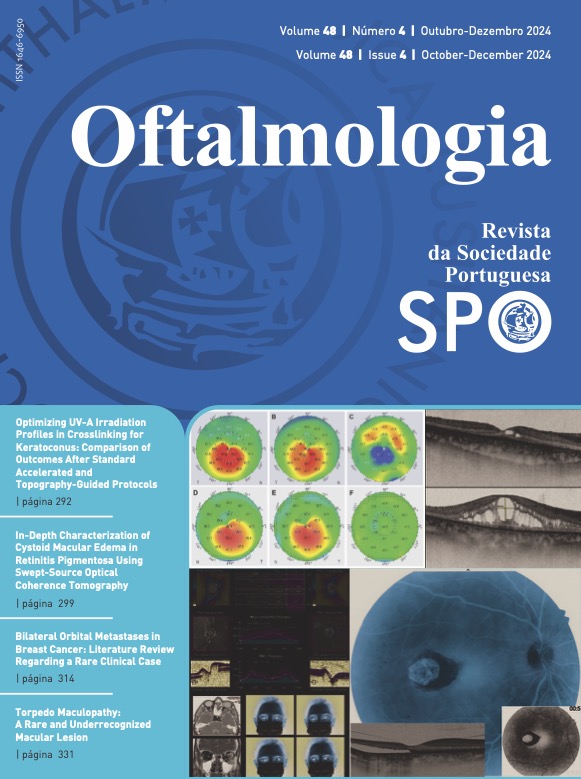In-Depth Characterization of Cystoid Macular Edema in Retinitis Pigmentosa Using Swept-Source Optical Coherence Tomography
DOI:
https://doi.org/10.48560/rspo.33236Keywords:
Macular Edema, Retinitis Pigmentosa, omography, Optical CoherenceAbstract
INTRODUCTION: Retinitis pigmentosa (RP) may be complicated by cystoid macular edema (CME), which contributes to central vision loss. The underlying pathophysiology of RP-associated CME (RP-CME) and its impact in prognosis remains uncertain. Our objective was to investigate the association between cystoid spaces (CS), retinal morphometric parameters and clinical data in RP-CME using swept-source optical coherence tomography (SS-OCT).METHODS: Prospective study conducted at an IRD referral center in Portugal. Consecutive RP patients with evidence of CME were recruited from the Retinal Dystrophies Clinic and invited to undergo SS-OCT (Zeiss PLEX Elite 9000). Morphometric assessment using the in-built software was performed by 2 independent graders (CC and CN) and included: central point outer nuclear layer thickness (CPONLT), ellipsoid zone area (EZA), central macular thickness (CMT), CS location (central point, central millimeter, outside central millimeter), CS retinal layer involvement and CS size. Clinical data, such as gender, age, genetic variants, best-corrected visual acuity (BCVA), lens status and vitreomacular interface status were registered.
RESULTS: We enrolled 40 eyes from 21 patients (71.5% male; mean age 47.3±15.2 years). In 61.90% the inheritance pattern was autosomal recessive, 80.95% had non-syndromic disease and 90.48% had bilateral CME. Mean BCVA was 68.06±14.55 ETDRS letters. CS were found in the inner nuclear layer in 100% of eyes and in the outer nuclear layer in 50%. CS involved the central point or central millimeter in 85% eyes (17 eyes each); 6 cases (15%) showed CS outside central millimeter. Size and retinal layer involvement were not associated with BCVA (p=0.548 and p=0.285). CS in the central point were associated with higher EZA when compared to those without central point involvement (p=0.009). EZA and CPONLT correlated with BCVA (r=0.351, p=0.0286 and r=0.387, p=0.0462).
CONCLUSION: CS involving the central point were associated with higher EZA values, showing that central point involvement happens in less severe disease stages with more preserved visual function. The correlation between CPONLT and BCVA highlights the importance of this outer retinal layer for visual function in RP-CME. Further studies are needed to obtain a profound understanding of this entity along with the true impact of CS in visual function.
Downloads
References
Dias MF, Joo K, Kemp JA, Fialho SL, da Silva Cunha A Jr, Woo SJ, et al. Molecular genetics and emerging therapies for retinitis pigmentosa: Basic research and clinical perspectives. Prog Retin Eye Res. 2018;63: 107–31. doi: 10.1016/j.preteyeres.2017.10.004.
Marques JP, Carvalho AL, Henriques J, Murta JN, Saraiva J, Silva R. Design, development and deployment of a web-based interoperable registry for inherited retinal dystrophies in Portugal: the IRD-PT. Orphanet J Rare Dis. 2020;15: 304. doi: 10.1186/s13023-020-01591-6.
Marques JP, Vaz-Pereira S, Costa J, Marta A, Henriques J, Silva R. Challenges, facilitators and barriers to the adoption and use of a web-based national IRD registry: lessons learned from the IRD-PT registry. Orphanet J Rare Dis. 2022;17: 323. doi: 10.1186/s13023-022-02489-1.
Santos T, Warren LH, Santos AR, Marques IP, Kubach S, Mendes LG, et al. Swept-source OCTA quantification of capillary closure predicts ETDRS severity staging of NPDR. Br J Ophthalmol. 2022;106: 712–8. doi: 10.1136/bjophthalmol-2020-317890.
Ogino K, Oishi A, Oishi M, Gotoh N, Morooka S, Sugahara M, et al. Efficacy of column scatter plots for presenting retinitis pigmentosa phenotypes in a japanese cohort. Transl Vis Sci Technol. 2016;5: 4. doi: 10.1167/tvst.5.2.4.
Sorrentino FS, Gallenga CE, Bonifazzi C, Perri P. A challenge to the striking genotypic heterogeneity of retinitis pigmentosa: a better understanding of the pathophysiology using the newest genetic strategies. Eye. 2016;30: 1542–8. doi: 10.1038/eye.2016.197.
Bonilha VL, Rayborn ME, Bell BA, Marino MJ, Pauer GJ, Beight CD, et al. Histopathological comparison of eyes from patients with autosomal recessive retinitis pigmentosa caused by novel EYS mutations. Graefes Arch Clin Exp Ophthalmol. 2015;253: 295–305. doi: 10.1007/s00417-014-2868-z.
Hartong DT, Berson EL, Dryja TP. Retinitis pigmentosa. Lancet. 2006;368: 1795–809. doi: 10.1016/S0140-6736(06)69740-7.
Fishman GA, Maggiano JM, Fishman M. Foveal lesions seen in retinitis pigmentosa. Arch Ophthalmol. 1977;95: 1993–6. doi: 10.1001/archopht.1977.04450110087008.
Marques JP, Neves E, Geada S, Carvalho AL, Murta J, Saraiva J, et al. Frequency of cystoid macular edema and vitreomacular interface disorders in genetically solved syndromic and non-syndromic retinitis pigmentosa. Graefes Arch Clin Exp Ophthalmol. 2022;260: 2859–66. doi: 10.1007/s00417-02205649-y.
Chen C, Liu X, Peng X. Management of cystoid macular edema in retinitis pigmentosa: a systematic review and meta-analysis. Front Med. 2022;9: 895208. doi: 10.3389/fmed.2022.895208.
Bakthavatchalam M, Lai FHP, Rong SS, Ng DS, Brelen ME. Treatment of cystoid macular edema secondary to retinitis pigmentosa: a systematic review. Surv Ophthalmol. 2018;63: 329–39. doi: 10.1016/j.survophthal.2017.09.009.
Yeo JH, Kim YJ, Yoon YH. Optical coherence tomography angiography in patients with retinitis pigmentosa-associated cystoid macular edema. Retina. 2020;40: 2385–95. doi: 10.1097/IAE.0000000000002756.
Gorovoy IR, Gallagher DS, Eller AW, Mayercik VA, Friberg TR, Schuman JS. Cystoid macular edema in retinitis pigmentosa patients without associated macular thickening. Semin Ophthalmol. 2013;28: 79–83. doi: 10.3109/08820538.2012.760614.
Strong S, Liew G, Michaelides M. Retinitis pigmentosa-associated cystoid macular oedema: pathogenesis and avenues of intervention. Br J Ophthalmol. 2017;101: 31–7. doi: 10.1136/bjophthalmol-2016-309376.
Strong SA, Hirji N, Quartilho A, Kalitzeos A, Michaelides M. Retrospective cohort study exploring whether an association exists between spatial distribution of cystoid spaces in cystoid macular oedema secondary to retinitis pigmentosa and response to treatment with carbonic anhydrase inhibitors. Br J Ophthalmol. 2019;103: 233–7. doi: 10.1136/bjophthalmol-2017-311392.
Hajali M, Fishman GA, Anderson RJ. The prevalence of cystoid macular oedema in retinitis pigmentosa patients determined by optical coherence tomography. Br J Ophthalmol. 2008;92: 1065–8. doi: 10.1136/bjo.2008.138560.
Hajali M, Fishman GA. The prevalence of cystoid macular oedema on optical coherence tomography in retinitis pigmentosa patients without cystic changes on fundus examination. Eye. 2009;23: 915–9. doi: 10.1038/eye.2008.110.
Testa F, Rossi S, Colucci R, Gallo B, Di Iorio V, della Corte M, et al. Macular abnormalities in Italian patients with retinitis pigmentosa. Br J Ophthalmol. 2014;98: 946–50. doi: 10.1136/bjophthalmol-2013-304082.
Liew G, Strong S, Bradley P, Severn P, Moore AT, Webster AR, et al. Prevalence of cystoid macular oedema, epiretinal membrane and cataract in retinitis pigmentosa. Br J Ophthalmol. 2019;103: 1163–6. doi: 10.1136/bjophthalmol-2018-311964.
Richards S, Aziz N, Bale S, Bick D, Das S, Gastier-Foster J, et al. Standards and guidelines for the interpretation of sequence variants: a joint consensus recommendation of the American College of Medical Genetics and Genomics and the Association for Molecular Pathology. Genet Med. 2015;17: 405–24. doi: 10.1038/gim.2015.30.
Govetto A, Lalane RA, Sarraf D, Figueroa MS, Hubschman JP. Insights into epiretinal membranes: presence of ectopic inner foveal layers and a new optical coherence tomography staging scheme. Am J Ophthalmol. 2017;175: 99–113. doi: 10.1016/j.ajo.2016.12.006.
Bamahfouz A. Correlation of central macular thickness and the best-corrected visual acuity in three months after cataract surgery by phacoemulsification and with intraocular lens implantation. Cureus. 2021;13: e13856. doi: 10.7759/cureus.13856.
Wang P, Hu Z, Hou M, Norman PA, Chin EK, Almeida DR. Relationship between macular thickness and visual acuity n the treatment of diabetic macular edema with anti-VEGF therapy: systematic review. J Vitreoretin Dis. 2023;7: 57–64. doi: 10.1177/24741264221138722.
Lassiale S, Valamanesh F, Klein C, Hicks D, Abitbol M, Versaux-Botteri C. Changes in aquaporin-4 and Kir4.1 expression in rats with inherited retinal dystrophy. Exp Eye Res. 2016;148: 33–44. doi: 10.1016/j.exer.2016.05.010.
Mimouni M, Nahum Y, Levant A, Levant B, Weinberger D. Cystoid macular edema: a correlation between macular volumetric parameters and visual acuity. Can J Ophthalmol. 2014;49: 183–7. doi: 10.1016/j.jcjo.2013.11.004.
Arias JD, Kalaw FGP, Alex V, Yassin SH, Ferreyra H, Walker E, et al. Investigating the associations of macular edema in retinitis pigmentosa. Sci Rep. 2023;13:14187. doi: 10.1038/s41598-023-41464-z.
Ruff A, Tezel A, Tezel TH. Anatomical and functional correlates of cystic macular edema in retinitis pigmentosa. PLoS One. 2022;17: e0276629. doi: 10.1371/journal.pone.0276629.
Downloads
Published
How to Cite
Issue
Section
License
Copyright (c) 2024 Revista Sociedade Portuguesa de Oftalmologia

This work is licensed under a Creative Commons Attribution-NonCommercial 4.0 International License.
Do not forget to download the Authorship responsibility statement/Authorization for Publication and Conflict of Interest.
The article can only be submitted with these two documents.
To obtain the Authorship responsibility statement/Authorization for Publication file, click here.
To obtain the Conflict of Interest file (ICMJE template), click here





